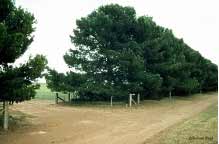|
Trees for Wind Shelter

Shelterbelts or windbreaks are narrow belts of trees designed
to block damaging winds. As a result of wind tunnel research
we now know a great deal about how the design and management
of a belt of trees might influence wind speed on both sides
of the belt. Field based studies undertaken across Australia
as part of a national windbreaks research program has provided
practical experience to support this theory.
Basic Function Of A Shelter Belt And
Surface Roughness
A universal function that describes wind flow for a long,
thin wind barrier standing on a large, flat surface with the
wind blowing normal (perpendicular) to the barrier:
.gif)
Where:
U = mean horizontal wind speed
Uh = mean approach horizontal wind speed at barrier top height
in the open
h = shelterbelt height
x = perpendicular distance from the windbreak
z = height above the surface
zo = surface roughness parameter
L = Monin-Obukhov stability length (a measure of atmospheric
stability)
P = shelter belt porosity (ratio of perforated area to total
area)
Reference: McNaughton, K.G. (1988),
'Effects of Windbreaks on Turbulent Transport and Microclimate',
Agriculture Ecosystems and Environment, Vol. 22/23, pp 17-40
Surface roughness is only one of many factors that will influence
the efficiency of a shelter belt However the greater the surface
roughness preceding a shelter belt, the greater the turbulence
of the wind hitting the windbreak and therefore the lower
the efficiency of the windbreak. Likewise, atmospheric stability
will also influence shelterbelt efficiency. Farmers may be
able to influence the orientation, height andporosity of a
shelterbelt. They might also be able to manage their crops
or stock effectively so as to take advantage of the shelter
provided.
The extent of the shelter effect is directly proportional
to the height of the belt and this is why it is common to
express the extent of the shelter effect as a multiple of
tree (or belt) height, e.g. 20H is 20 times the tree (or belt)
height. Shelter effects have been routinely measured to 20H
- 25H, with the effect of the shelterbelt being marginal after
30H.
Windspeed at Distances from Windbreak
.gif)
Reference: Cleugh, H. (1997), 'Trees for Shade and Shelter'
in Design Principles for Farm Forestry: A guide to assist
farmers to decide where to plant trees and farm plantations
on farms eds. Abel, N. et al, RIRDC, Canberra, pp.39-52
Shelterbelt
Examples
Orientation
of Shelterbelts
Porosity of
the Shelterbelt
Gaps and End Effects
Effect of Shelterbelts
on Microclimate
Effect
of Multiple Shelterbelts
The effect of scattered trees and plantations on wind speeds
is quite different to that of shelterbelts. In the case of
scattered trees, the strongest winds tend to flow evenly over
the top of the canopies, leaving the wind speeds at ground
level much lower over the whole area. Measurements taken amongst
widely spaced trees spread across grazing land indicate that
reductions in wind speed of 40% over the whole paddock are
possible with just 17 large remnant eucalypt trees per hectare,
or about 200 young pruned timber trees per hectare. The larger
the trees or the greater the stocking rate, the slower the
wind speed will be. Such areas may be valuable as stock havens
for ‘off-shears’ sheep or developed as special lambing
or calving areas.
.gif)
Back to top
|
